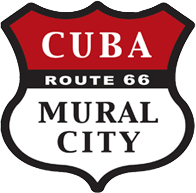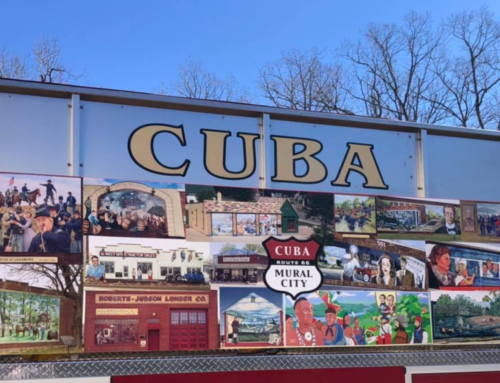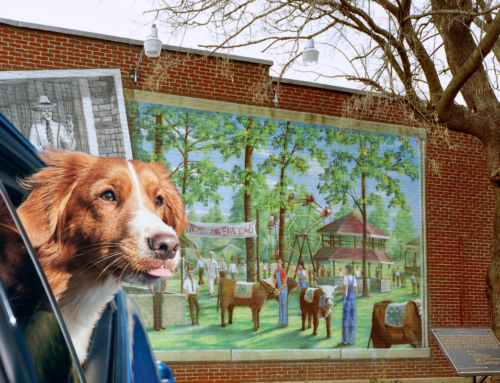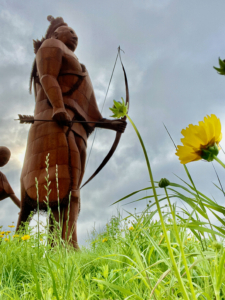 When you think of the Wild West, there is usually an image of cowboys on saddled horses and natives riding bareback. But there was a time before horses in North America when the native people traveled on foot or by canoe.
When you think of the Wild West, there is usually an image of cowboys on saddled horses and natives riding bareback. But there was a time before horses in North America when the native people traveled on foot or by canoe.
Many of Missouri’s major highways, including Route 66, roughly follow ancient trails used by the indigenous people.
These roads have always followed the trail of the Osage Nation. The Osage, a prominent tribe in Missouri, made seasonal moves to hunt and gather for the group.
Famed Missouri Archaeologist Carl H. Chapman (born 1915 in Steelville, MO) reveals these indigenous societies were in the region as long as 12,000 – 14,000 years before the arrival of the Spanish, French, and English.
The early Osage tribes were believed to be a semi-nomadic prairie culture of hunters and gatherers. By the 13th and 14th centuries, native cultures began to decline and disperse. Over time, the Osage were known as the Wazhazhe or “children of the middle waters.” The French had difficulty pronouncing the name, therefore using Osage instead.
By the 18th century, the new nation maintained aspects of British imperialism and settler colonialism. To benefit the new empire, there was the need to build settler colonies. The plan would eliminate indigenous inhabitants to embrace westward expansion. The aftermath of the 1803 Louisiana Purchase accelerated the federal government’s use of treaties to reduce the indigenous populations and their land.
Once Missouri became a state in 1821 the work began to remove all indigenous tribes from the state. Governor Clark of Missouri gave directives to remove all Osage from Missouri based on the language of the 1825 Treaty.
As more settlers moved west of the Appalachian Mountains, eastern indigenous nations like the Fox, Kickapoo, Delaware, Shawnee, and Cherokee were forced to flee. At the same time, politicians in the midwest were moving the mid-western Native nations even further west into Oklahoma.
 During this expansion of the new nation, the Trail of Tears resulted from the Indian Removal Act of 1830. Signed into law by President Andrew Jackson, the Indian Removal Act authorized the president to grant lands west of the Mississippi in exchange for land occupied by native tribes. While a few tribes acquiesced, many resisted. Historians continue to explore the true devastation and inhumane treatment of the indigenous people. It is estimated that over 100,000 Native Americans were moved westward on the Trail of Tears, while thousands died during the journey.
During this expansion of the new nation, the Trail of Tears resulted from the Indian Removal Act of 1830. Signed into law by President Andrew Jackson, the Indian Removal Act authorized the president to grant lands west of the Mississippi in exchange for land occupied by native tribes. While a few tribes acquiesced, many resisted. Historians continue to explore the true devastation and inhumane treatment of the indigenous people. It is estimated that over 100,000 Native Americans were moved westward on the Trail of Tears, while thousands died during the journey.
The Osage traveled the Trail of Tears to southeast Kansas. By the time they negotiated the treaty of 1865 to purchase land in Oklahoma, the journey had reduced the population of the tribe by over 95 percent. By 1870, Congress sold the land in southeast Kansas. The Osage were relocated yet again to what is now Osage County in Oklahoma. Oil was later discovered on this small desolate piece of land. The Osage Allotment Act of 1906 ensured the Osage the mineral rights to their land.
The Osage Allotment Act of 1906 gave the Osage assurance they would retain mineral rights to the land. Oil companies bid for land rights under the shade of a spreading elm in Pawhuska. With the oil, came wealth, vengeance, and murder. A bestselling book, Killers of the Flower Moon, by David Grann, unfolds the 1920s true story of the Osage murders and the start of the Federal Bureau of Investigation (FBI). Now adapted as a movie, Killers of the Flower Moon is a star-studded cast directed by Martin Scorsese.
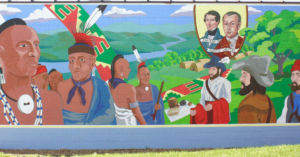 In 2014, the city and citizens of Cuba, Missouri welcomed back the Osage Nation with the Osage Trail Legacy. A metal sculpture by artist Glen Tutterrow stands proudly at the Cuba Visitor Center and depicts an ancient Osage family on the move westward. Encircled by a small walking park, the 35-foot sculpture includes the chief, mother and baby, young daughter, and their beast of burden, the domesticated red wolf. The larger-than-life monument can be seen from Interstate 44 at Exit 208. Cuba is proud to welcome back the Osage Nation with the largest sculpture ever dedicated and erected to the Osage Nation. Also, along Route 66, there is a mural dedicated to the early meeting of the Osage and the French explorers, painted by mural artist Norman Akers.
In 2014, the city and citizens of Cuba, Missouri welcomed back the Osage Nation with the Osage Trail Legacy. A metal sculpture by artist Glen Tutterrow stands proudly at the Cuba Visitor Center and depicts an ancient Osage family on the move westward. Encircled by a small walking park, the 35-foot sculpture includes the chief, mother and baby, young daughter, and their beast of burden, the domesticated red wolf. The larger-than-life monument can be seen from Interstate 44 at Exit 208. Cuba is proud to welcome back the Osage Nation with the largest sculpture ever dedicated and erected to the Osage Nation. Also, along Route 66, there is a mural dedicated to the early meeting of the Osage and the French explorers, painted by mural artist Norman Akers.
Inside the Cuba Visitor Center, guests can watch an 8-minute documentary about the early Osage tribe and their presence in Missouri. The Cuba Visitor Center displays reprints of extraordinary oil paintings of the Osage by 19th-century artist George Catlin. Interestingly, Catlin’s interest in native people stemmed from his mother’s capture by natives as a child. The paintings, in critics’ words, “capture the human, not the savage” and went on to document the changing landscape of the West. The original Catlin paintings and hundreds of his Native American works remain on display at the Smithsonian American Art Museum in Washington, DC.
 Cuba, Missouri is situated along Route 66, just 80 miles south of St. Louis on Interstate 44, EXIT 208. This mural-filled town earned the moniker of Route 66 Mural City from the Missouri State Legislature in 2014. Located in the Crawford County area: Meramec River, Onondaga Cave, Crawford County Historical Society Museum, Historic Wagon Wheel Motel, and countless Route 66 attractions.
Cuba, Missouri is situated along Route 66, just 80 miles south of St. Louis on Interstate 44, EXIT 208. This mural-filled town earned the moniker of Route 66 Mural City from the Missouri State Legislature in 2014. Located in the Crawford County area: Meramec River, Onondaga Cave, Crawford County Historical Society Museum, Historic Wagon Wheel Motel, and countless Route 66 attractions.
https://missouriencyclopedia.org/people/chapman-carl-haley
https://treaties.okstate.edu/treaties/treaty-with-the-osage-1825-0217
https://motrailoftears.com/
https://www.osagenation-nsn.gov/
https://www.osagetraillegacy.com/
